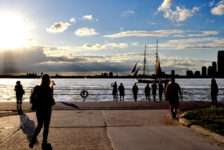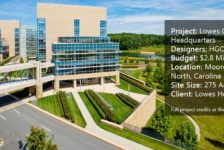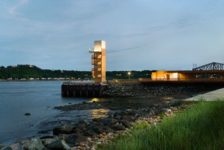18-January-2016 The Latest News in Landscape Architecture 2016 is sponsored by ZinCo – Life on Green Roofs – Ecological and Economical Green Roofs, worldwide. In this week’s Latest News in Landscape Architecture we reveal gardening and placemaking design trends for 2016, feature Houston’s proposed Botanic Garden, and discuss the importance of solid urban planning when implementing smart cities. Did you know that Songdo, South Korea is one of the world’s first smart cities?
Latest News in Landscape Architecture
10 of the Best Stories in this week’s latest news in landscape architecture:
- Gardening Trends for 2016 Focus on Eco-Sensitive Ways to Save Water and Pets
- New Public Squares Reveal Placemaking Design Trends
- Biggest Development Since the Inner Harbor Coming—To A City Where Developers Now Drive the Planning
- Producing the World’s First 3D-Printed Bridge With Robots “Is Just the Beginning”
- Full Bike Lanes and Cyclists Using Smartphones in Dutch Cities
- See a Rooftop Garden in Brooklyn Inspired by the High Line
- Here’s what Houston’s Botanic Garden Could Look Like
- The Wave: An Abandoned Urban Lot is Revived as a Thriving Performance Arts Space
- Australia’s Best Playground Competition Launched
- For Smart Cities: Need for Urban Planning Stressed
(Click the headline for the full story) Gardening Trends for 2016 Focus on Eco-Sensitive Ways to Save Water and Pets: The Seattle Times Garden Media Group recently released its 2016 trends report, “Syncing with Nature.” The report may seem a bit “cutesy” at first however after digging deeper it unveils several legitimate developments. Beginning with overly enhanced digital apps to make gardening seemingly more desirable for the younger set or those new to gardening the report goes on to describe “naTECHure”, which is the intersection of nature and technology. In addition, the report recommends organic lawn products amidst the staggering finding that 1 in 3 dogs will come down with cancer from harmful chemicals used on plants and lawns. Related Article: Find the Perfect Plants for Your Projects
While cities across the United States continue to grow, public squares are forced to evolve to keep pace with the diverse demands. From Philadelphia’s Dilworth Park to Cleveland’s Public Square — these are just two examples showcasing the progression of public space in the United States. Key trends being implemented include the use of increased hardscaping, eliminating lawns (or using sparingly), and the decline of single use elements. “The challenge there is how to still maintain it as a place that’s in the public realm, that is a place where democracy, where spontaneous events can happen, or a demonstration can happen, and at the same time find ways to derive revenue that can pay for the maintenance of the park at a high level,” says Richard Maimon, partner at Philadelphia firm KieranTimberlake. Related Article: How Can Redesigning a Public Space Change People’s Behavior? WATCH: Dilworth Park – The “People’s Park”
- Biggest Development Since the Inner Harbor Coming—To A City Where Developers Now Drive the Planning: Baltimore Brew
Since waterfront development was first used as a strategy to spur growth in Baltimore the city has settled for private developer led campaigns. Under Armour’s CEO Kevin Plank’s 20-year master plan for redeveloping Port Covington has skeptics excited yet nervous. The plan by Plank’s real estate arm, Sagamore Development Company, was especially praised last week because it calls for continuous public access all along the shoreline of the Middle Branch of the Patapsco River. The plan calls for construction of up to 13 million square feet of space on 266 acres, including a new world headquarters campus for Under Armour on 50 acres on a peninsula at the center of the property. The rest of the development is a mix of residences, offices, shops, restaurants, work spaces, maker spaces, public parks, squares, streets and promenades.
A new research and development company co-founded by Joris Laarman and Tim Geurtjens known as MX3D is developing a robot to 3D print an 8-meter bridge in Amsterdam. Ultimately, the team contends that this technology could be used to produce “endless” different structures. If all goes well the world’s first functional 3D-printed steel bridge over a canal in Amsterdam is slated for 2017. “The basics of the technology is pretty simple,” Laarman explains in the movie, which was filmed at MX3D’s workshop in Amsterdam. “We’re using an industrial robot that is usually used in assembly lines in the car industry. We have combined this with a welding machine and our own software to have it 3D print in metal.” WATCH: Producing the world’s first 3D-printed bridge with robots “is just the beginning”
Stichting Wetenschappelijk Onderzoek Verkeersveiligheid (Foundation for the Scientific Study of Traffic safety) conducted a recent study in The Hague and Amsterdam, but the results are representative of other large Dutch cities as well. According to the study, 20 percent of cyclists use smartphones (mainly for listening to music or making a phone call) per installed video cameras around four bike lanes in both cities. However, a whopping 80 percent of cyclists observed didn’t look behind them before initiating a passing maneuver. Overcrowded bike lanes remain a serious concern and the director of the foundation, Peter van der Knaap, said it is possible that parking spaces for cars will have to be sacrificed in order to widen cycling lanes. Related Article: Fabulous Bicycle Path Inspired by Van Gogh’s “Starry Night” WATCH: Amsterdam cyclists during rush hour
5 More Top Stories in the News This Week:
- See a Rooftop Garden in Brooklyn Inspired by the High Line: Architectural Digest
- Here’s what Houston’s Botanic Garden Could Look Like: Houston Business Journal
- The Wave: An Abandoned Urban Lot is Revived as a Thriving Performance Arts Space: Inhabitat
- Australia’s Best Playground Competition Launched: Architecture AU
- For Smart Cities: Need for Urban Planning Stressed: The Express Tribune
– Have something to say about this week’s news stories Go to comments For all of the hottest news continue to follow us on Facebook and Twitter. Do you have news to share? Send to office@landarchs.com News report by Brett Lezon Return to Homepage
Published in Blog






